Potential Effects of Urbanization on Precipitation Extremes in the Pearl River Delta Region, China
Abstract
:1. Introduction
2. Materials and Methods
2.1. Study Area
2.2. Data Pre-Processing and Extreme Precipitation Indices
2.3. Classification of Urban and Rural Stations
2.4. Quantitation Analysis of Urbanization Effects and Contributions
2.5. Trend Detection of Precipitation Extremes
3. Results and Discussion
3.1. Long-Term Changes in Extreme Precipitation
3.2. Spatial Patterns of Extreme Precipitation
3.3. Urban–Rural Differences in Extreme Precipitation
3.4. Urbanization Effects and Contributions
3.5. Discussion
4. Conclusions
Supplementary Materials
Author Contributions
Funding
Institutional Review Board Statement
Informed Consent Statement
Data Availability Statement
Acknowledgments
Conflicts of Interest
References
- Grimm, N.B.; Faeth, S.H.; Golubiewski, N.E.; Redman, C.L.; Wu, J.G.; Bai, X.M.; Briggs, J.M. Global change and the ecology of cities. Science 2008, 319, 756–760. [Google Scholar] [CrossRef] [PubMed] [Green Version]
- Song, X.M.; Zhang, J.Y.; AghaKouchak, A.; Sen Roy, S.; Xuan, Y.Q.; Wang, G.Q.; He, R.M.; Wang, X.J.; Liu, C.S. Rapid urbanization and changes in spatiotemporal characteristics of precipitation in Beijing metropolitan area. J. Geophys. Res. Atmos. 2014, 119, 11250–11271. [Google Scholar] [CrossRef] [Green Version]
- Zhang, Y.Y.; Pang, X.; Xia, J.; Shao, Q.X.; Yu, E.; Zhao, T.; She, D.; Sun, J.; Yu, J.; Pan, X.; et al. Regional patterns of extreme precipitation and urban signatures in metropolitan areas. J. Geophys. Res. Atmos. 2019, 124, 641–663. [Google Scholar] [CrossRef]
- Zhang, H.; Wu, C.H.; Chen, W.J.; Huang, G.R. Effect of urban expansion on summer rainfall in the Pearl River Delta, South China. J. Hydrol. 2019, 568, 747–757. [Google Scholar] [CrossRef]
- Kalnay, E.; Cai, M. Impact of urbanization and land-use change on climate. Nature 2003, 423, 528–531. [Google Scholar] [CrossRef]
- Manoli, G.; Fatichi, S.; Schlapfer, M.; Yu, K.; Crowther, T.W.; Meili, N.; Burlando, P.; Katul, G.G.; Bou-Zeid, E. Magnitude of urban heat islands largely explained by climate and population. Nature 2019, 573, 55–60. [Google Scholar] [CrossRef]
- Luo, M.; Lau, N.C. Increasing Heat Stress in Urban Areas of Eastern China: Acceleration by Urbanization. Geophys. Res. Lett. 2018, 45, 13060–13069. [Google Scholar] [CrossRef]
- Zhao, N.; Jiao, Y.M.; Ma, T.; Zhao, M.M.; Fan, Z.M.; Yin, X.Z.; Liu, Y.; Yue, T.X. Estimating the effect of urbanization on extreme climate events in the Beijing-Tianjin-Hebei region, China. Sci. Total Environ. 2019, 688, 1005–1015. [Google Scholar] [CrossRef]
- Cao, Q.; Yu, D.; Georgescu, M.; Wu, J. Impacts of urbanization on summer climate in China: An assessment with coupled land-atmospehric modeling. J. Geophys. Res. Atmos. 2016, 121, 10505–10521. [Google Scholar] [CrossRef]
- Bounoua, L.; Zhang, P.; Mostovoy, G.; Thome, K.; Masek, J.; Imhoff, M.; Shepherd, M.; Quattrochi, D.; Santanello, J.; Silva, J.; et al. Impact of urbanization on US surface climate. Environ. Res. Lett. 2015, 10, 084010. [Google Scholar] [CrossRef] [Green Version]
- Chen, H.S.; Zhang, Y.; Yu, M.; Hua, W.J.; Sun, S.L.; Li, X.; Gao, C.J. Large-scale urbanization effects on eastern Asian summer monsoon circulation and climate. Clim. Dyn. 2016, 47, 117–136. [Google Scholar] [CrossRef]
- Chrysanthou, A.; van der Schrier, G.; van den Besselaar, E.J.M.; Tank, A.M.G.K.; Brandsma, T. The effects of urbanization on the rise of the European temperature since 1960. Geophys. Res. Lett. 2014, 41, 7716–7722. [Google Scholar] [CrossRef]
- Hao, L.; Sun, G.; Liu, Y.; Wan, J.; Qin, M.; Qian, H.; Liu, C.; Zheng, J.; John, R.; Fan, P.; et al. Urbanization dramatically altered the water balances of a paddy field-dominated basin in southern China. Hydrol. Earth Syst. Sci. 2015, 19, 3319–3331. [Google Scholar] [CrossRef] [Green Version]
- Ren, G.Y.; Zhou, Y.Q.; Chu, Z.Y.; Zhou, J.X.; Zhang, A.Y.; Guo, J.; Liu, X.F. Urbanization effects on observed surface air temperature trends in north China. J. Clim. 2008, 21, 1333–1348. [Google Scholar] [CrossRef] [Green Version]
- Zhou, X.F.; Chen, H. Impact of urbanization-related land use land cover changes and urban morphology changes on the urban heat island phenomenon. Sci. Total Environ. 2018, 635, 1467–1476. [Google Scholar] [CrossRef]
- Zhong, S.; Qian, Y.; Zhao, C.; Leung, R.; Yang, X.Q. A case study of urbanization impact on summer precipitation in the Greater Beijing Metropolitan Area: Urban heat island versus aerosol effects. J. Geophys. Res. Atmos. 2015, 120, 10903–10914. [Google Scholar] [CrossRef]
- Zhao, L.; Lee, X.; Smith, R.B.; Oleson, K. Strong contributions of local background climate to urban heat islands. Nature 2014, 511, 216–219. [Google Scholar] [CrossRef] [PubMed]
- Zhu, X.D.; Zhang, Q.; Sun, P.; Singh, V.P.; Shi, P.J.; Song, C.Q. Impact of urbanization on hourly precipitation in Beijing, China: Spatiotemporal patterns and causes. Glob. Planet. Chang. 2019, 172, 307–324. [Google Scholar] [CrossRef]
- Baklanov, A.; Molina, L.T.; Gauss, M. Megacities, air quality and climate. Atmos. Environ. 2016, 126, 235–249. [Google Scholar] [CrossRef]
- Yang, P.; Ren, G.Y.; Yan, P.C. Evidence for a Strong Association of Short-Duration Intense Rainfall with Urbanization in the Beijing Urban Area. J. Clim. 2017, 30, 5851–5870. [Google Scholar] [CrossRef]
- Fu, X.S.; Yang, X.Q.; Sun, X.G. Spatial and Diurnal Variations of Summer Hourly Rainfall Over Three Super City Clusters in Eastern China and Their Possible Link to the Urbanization. J. Geophys. Res.-Atmos. 2019, 124, 5445–5462. [Google Scholar] [CrossRef]
- Song, X.M.; Mo, Y.C.; Xuan, Y.Q.; Wang, Q.J.; Wu, W.Y.; Zhang, J.; Zou, X. Impacts of urbanization on precipitation patterns in the greater Beijing-Tianjin-Hebei metropolitan region in northern China. Environ. Res. Lett. 2021, 16, 014042. [Google Scholar] [CrossRef]
- Ren, G.Y.; Zhou, Y.Q. Urbanization Effect on Trends of Extreme Temperature Indices of National Stations over Mainland China, 1961–2008. J. Clim. 2014, 27, 2340–2360. [Google Scholar] [CrossRef]
- Mishra, V.; Ganguly, A.R.; Nijssen, B.; Lettenmaier, D.P. Changes in observed climate extremes in global urban areas. Environ. Res. Lett. 2015, 10, 024005. [Google Scholar] [CrossRef]
- Zhang, D.L. Rapid urbanization and more extreme rainfall events. Sci. Bull. 2020, 65, 516–518. [Google Scholar] [CrossRef] [Green Version]
- Sun, Y.; Hu, T.; Zhang, X.B.; Li, C.; Lu, C.H.; Ren, G.Y.; Jiang, Z.H. Contribution of Global warming and Urbanization to Changes in Temperature Extremes in Eastern China. Geophys. Res. Lett. 2019, 46, 11426–11434. [Google Scholar] [CrossRef] [Green Version]
- Zhang, P.F.; Ren, G.Y.; Qin, Y.; Zhai, Y.Q.; Zhai, T.L.; Tysa, S.K.; Xue, X.Y.; Yang, G.W.; Sun, X.B. Urbanization effects on estimates of global trends in mean and extreme air temperature. J. Clim. 2021, 34, 1923–1945. [Google Scholar] [CrossRef]
- Marelle, L.; Myhre, G.; Steensen, B.M.; Hodnebrog, Ø.; Alterskjær, K.; Sillmann, J. Urbanization in megacities increases the frequency of extreme precipitation events far more than their intensity. Environ. Res. Lett. 2020, 15, 124072. [Google Scholar] [CrossRef]
- Li, Y.; Wang, W.; Chang, M.; Wang, X. Impacts of urbanization on extreme precipitation in the Guangdong-Hong Kong-Macau greater bay area. Urban Clim. 2021, 38, 100904. [Google Scholar] [CrossRef]
- Singh, J.; Karmakar, S.; PaiMazumder, D.; Ghosh, S.; Niyogi, D. Urbanization alters rainfall extremes over the contiguous United States. Environ. Res. Lett. 2020, 15, 074033. [Google Scholar] [CrossRef] [Green Version]
- Sun, Y.; Zhang, X.B.; Ren, G.Y.; Zwiers, F.W.; Hu, T. Contribution of urbanization to warming in China. Nat. Clim. Chang. 2016, 6, 706–709. [Google Scholar] [CrossRef]
- Wang, F.; Ge, Q.S.; Wang, S.W.; Li, Q.X.; Jones, P.D. A New Estimation of Urbanization’s Contribution to the Warming Trend in China. J. Clim. 2015, 28, 8923–8938. [Google Scholar] [CrossRef]
- Zhao, D.; Wu, J. Comparisons of urban-related warming in Beijing using different methods to calculate the daily mean temperature. Sci. China Earth Sci. 2019, 62, 693–702. [Google Scholar] [CrossRef]
- Lin, L.; Gao, T.; Luo, M.; Ge, E.; Yang, Y.; Liu, Z.; Zhao, Y.; Ning, G. Contribution of urbanization to the changes in extreme climate events in urban agglomerations across China. Sci. Total Environ. 2020, 744, 140264. [Google Scholar] [CrossRef]
- Chen, S.; Li, W.; Du, Y.; Mao, C.; Zhang, L. Urbanization effect on precipitation over the Pearl River Delta based on CMORPH data. Adv. Clim. Chang. Res. 2015, 6, 16–22. [Google Scholar] [CrossRef]
- Wang, D.; Jiang, P.; Wang, G.; Wang, D. Urban extent enhances extreme precipitation over the Pearl River Delta, China. Atmos. Sci. Lett. 2015, 16, 310–317. [Google Scholar] [CrossRef]
- Yan, M.; Chan, J.; Zhao, K. Impacts of urbanization on the precipitation characteristics in Guangdong Province, China. Adv. Atmos. Sci. 2020, 37, 696–706. [Google Scholar] [CrossRef]
- Hu, C.; Fung, K.Y.; Tam, C.Y.; Wang, Z. Urbanization impacts on Pearl River Delta extreme rainfall sensitivity to land cover change versus anthropogenic heat. Earth Space Sci. 2021, 8, e2020EA001536. [Google Scholar] [CrossRef]
- Fung, K.Y.; Tam, C.Y.; Lee, T.C.; Wang, Z.Q. Comparing the influence of global warming and urban anthropogenic heat on extreme precipitation in urbanized Pearl River Delta area based on dynamical downscaling. J. Geophys. Res. Atmos. 2021, 126, e2021JD035047. [Google Scholar] [CrossRef]
- Holst, C.; Tam, C.; Chan, J. Sensitivity of urban rainfall to anthropogenic heat flux: A numerical experiment. Geophys. Res. Lett. 2016, 43, 2240–2248. [Google Scholar] [CrossRef] [Green Version]
- Su, C.; Chen, X. Covariates for nonstationary modeling of extreme precipitation in the Pearl River Basin, China. Atmos. Res. 2019, 229, 224–239. [Google Scholar] [CrossRef]
- Zou, X.; Song, X.; Liu, C.; Zhang, C. Spatiotemporal changes of precipitation characteristics in the Pearl River Delta region during flood season. Water Resour. Hydropower Eng. 2021, 52, 21–32. [Google Scholar] [CrossRef]
- Chen, X.; Zhang, H.; Chen, W.; Huang, G. Urbanization and climate change impacts on future flood risk in the Pearl River Delta under shared socioeconomic pathways. Sci. Total Environ. 2021, 762, 143144. [Google Scholar] [CrossRef] [PubMed]
- Song, X.; Zou, X.; Zhang, C.; Zhang, J.; Kong, F. Multiscale spatiotemporal changes of precipitation extremes in Beijing-Tianjin-Hebei region, China during 1958–2017. Atmosphere 2019, 10, 462. [Google Scholar] [CrossRef] [Green Version]
- Song, X.; Zou, X.; Mo, Y.; Zhang, J.; Zhang, C.; Tian, Y. Nonstationary Bayesian modeling of precipitation extremes in the Beijing-Tianjin-Hebei region, China. Atmos. Res. 2020, 242, 105006. [Google Scholar] [CrossRef]
- Yang, X.; Leung, L.R.; Zhao, N.; Zhao, C.; Qian, Y.; Hu, K.; Liu, X.; Chen, B. Contribution of urbanization to the increase of extreme heat events in an urban agglomeration in east China. Geophys. Res. Lett. 2017, 44, 6940–6950. [Google Scholar] [CrossRef]
- Khoi, D.N.; Quan, N.T.; Nhi, P.T.T.; Nguyen, V.T. Impact of climate change on precipitation extremes over Ho Chi Minh City, Vietnam. Water 2021, 13, 120. [Google Scholar] [CrossRef]
- Abbas, F.; Farooque, A.; Afzaal, H. Homogeneity in patterns of climate extremes between two cities—A potential for flood planning in relation to climate change. Water 2020, 12, 782. [Google Scholar] [CrossRef] [Green Version]
- Liao, W.; Liu, X.; Li, D.; Luo, M.; Wang, D.; Wang, S.; Baldwin, J.; Lin, L.; Li, X.; Feng, K.; et al. Stronger contributions of urbanization to heat wave trends in wet climates. Geophys. Res. Lett. 2018, 45, 11310–11317. [Google Scholar] [CrossRef] [Green Version]
- Wu, M.; Luo, Y.; Chen, F.; Wong, W. Observed link of extreme hourly precipitation changes to urbanization over coastal South China. J. Appl. Meteorol. Climatol. 2019, 58, 1799–1819. [Google Scholar] [CrossRef]
- Felix, M.L.; Kim, Y.; Choi, M.; Kim, J.; Do, X.K.; Nguyen, T.H.; Jung, K. Detailed trend analysis of extreme climate indices in the Upper Geum River Basin. Water 2021, 13, 3171. [Google Scholar] [CrossRef]
- Gulakhmadov, A.; Chen, X.; Gulahmadov, N.; Liu, T.; Davlyatov, R.; Sharofiddinov, S.; Gulahmadov, M. Long-term hydroclimatic trends in the mountainous Kofarnihon River basin in Central Asia. Water 2020, 12, 2140. [Google Scholar] [CrossRef]
- Zeng, Z.; Wu, W.; Li, Y.; Zhou, Y.; Zhang, Z.; Zhang, S.; Guo, Y.; Huang, H.; Li, Z. Spatiotemporal variations in drought and wetness from 1965 to 2017 in China. Water 2020, 12, 2097. [Google Scholar] [CrossRef]
- Zou, X.; Song, X.; Liu, C. Spatiotemporal changes of extreme precipitation in the Pearl River Delta region. Hydro-Sci. Eng. 2022; in press. [Google Scholar] [CrossRef]
- Wang, X.; Liao, J.; Zhang, J.; Shen, C.; Chen, W.; Xia, B.; Wang, T. A numeric study of regional climate change induced by urban expansion in the Pearl River Delta, China. J. Appl. Meteorol. Climatol. 2014, 53, 346–362. [Google Scholar] [CrossRef]
- Li, X.; Wei, Z.; Wang, H.; Ma, L.; Guo, S. Variations in precipitation extremes over the Guangdong-Hong Kong-Macao Greater Bay Area in China. Theor. Appl. Climatol. 2022, 147, 381–394. [Google Scholar] [CrossRef]
- Gu, X.; Zhang, Q.; Singh, V.P.; Song, C.; Sun, P.; Li, J. Potential contributions of climate change and urbanization to precipitation trends across China at national, regional and local scales. Int. J. Climatol. 2019, 39, 2998–3012. [Google Scholar] [CrossRef]
- Qian, Y.; Chakraborty, T.C.; Li, J.; Li, D.; He, C.; Sarangi, C.; Chen, F.; Yang, X.; Leung, L.R. Urbanization impact on regional climate and extreme weather: Current understanding, uncertainties, and future research directions. Adv. Atmos. Sci. 2022, 39, 819–860. [Google Scholar] [CrossRef]
- Donat, M.; Lowry, A.; Alexander, L.; O’Gorman, P.; Maher, N. More extreme precipitation in the world’s dry and wet regions. Nat. Clim. Chang. 2016, 6, 508–513. [Google Scholar] [CrossRef]
- Min, S.; Zhang, X.; Zwiers, F.; Hegerl, G. Human contribution to more-intense precipitation extremes. Nature 2011, 470, 378–381. [Google Scholar] [CrossRef]
- Dunn, R.; Alexander, L.; Donat, M.; Zhang, X.; Bador, M.; Herold, N.; Lippmann, T.; Allan, R.; Aguilar, E.; Barry, A.A.; et al. Development of an updated global land in situ-based data set of temperature and precipitation extremes: HadEX3. J. Geophy. Res.-Atmos. 2020, 1225, e2019JD032263. [Google Scholar] [CrossRef]
- Huang, G.; Chen, Y.; Yao, Z. Spatial and temporal evolution characteristics of extreme rainfall in the Pearl River Delta under high urbanization. Adv. Water Sci. 2021, 32, 161–170. [Google Scholar] [CrossRef]
- Wang, Y.; Han, Z.; Gao, Y. Changes of extreme high temperature and heavy precipitation in the Guangdong-Hong Kong-Macao Greater Bay Area. Geomat. Nat. Hazards Risks 2021, 12, 1101–1126. [Google Scholar] [CrossRef]
- Jia, J.; Long, X. Study on spatio-temporal distribution characteristics of extreme precipitation in Guangdong province. Water Resour. Hydropower Eng. 2018, 49, 43–51. [Google Scholar] [CrossRef]
- Xu, S.; Sun, Y.; Zhao, S. Contemporary urban expansion in the first fastest growing metropolitan region of China: A multicity study in the Pearl River Delta urban agglomeration from 1980 to 2015. Urban Sci. 2021, 5, 11. [Google Scholar] [CrossRef]
- Li, H.; Chen, H.; Wang, H. Effects of anthropogenic activity emerging as intensified extreme precipitation over China. J. Geophys. Res.-Atmos. 2017, 122, 6899–6914. [Google Scholar] [CrossRef]
- Jiang, P.; Wang, D.; Cao, Y. Spatiotemporal characteristics of precipitation concentration and their possible links to urban extent in China. Theor. Appl. Climatol. 2016, 123, 757–768. [Google Scholar] [CrossRef]
- Kang, C.; Luo, Z.; Zong, W.; Hua, J. Impacts of urbanization on variations of extreme precipitation over the Yangtze River Delta. Water 2021, 13, 150. [Google Scholar] [CrossRef]
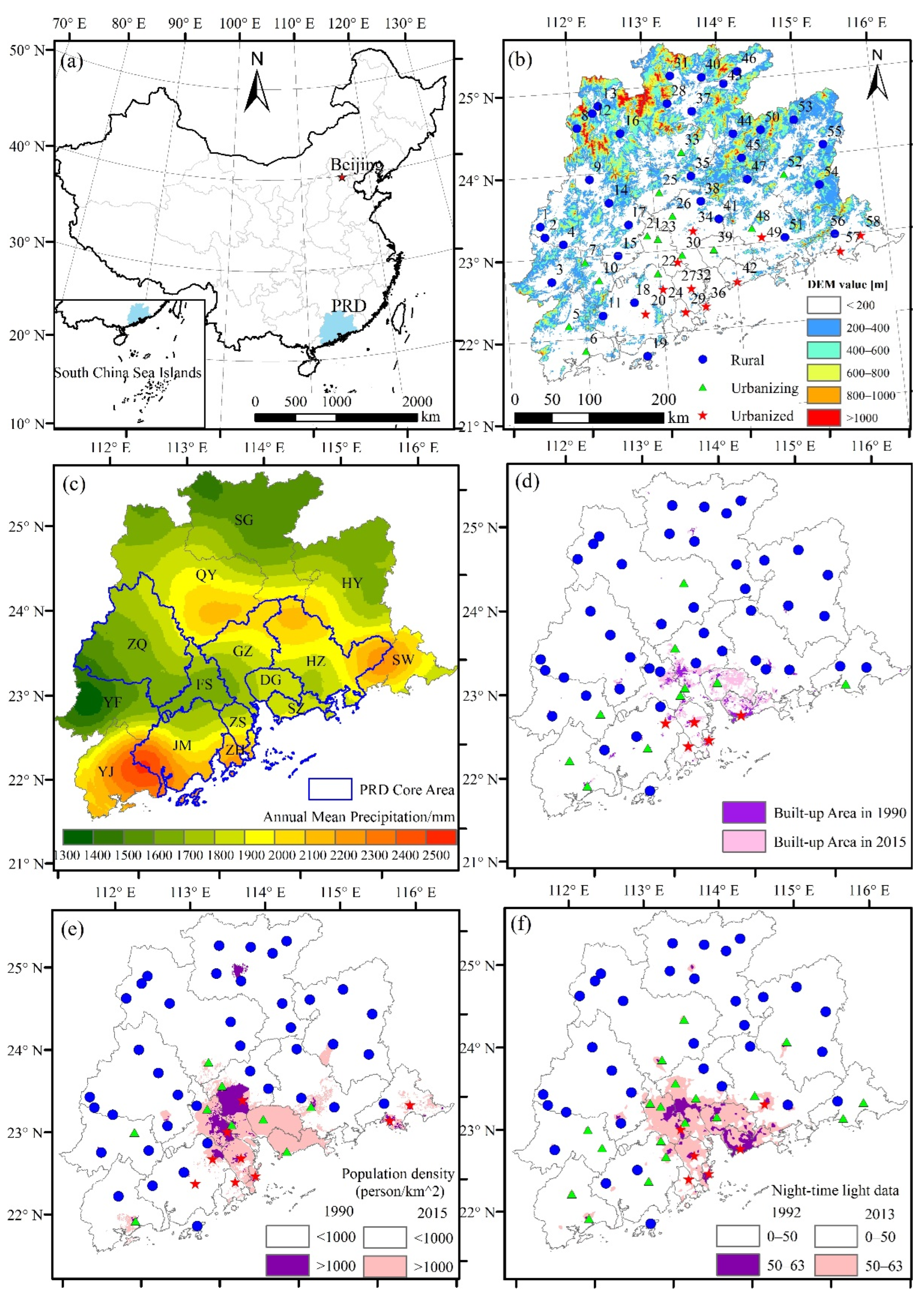

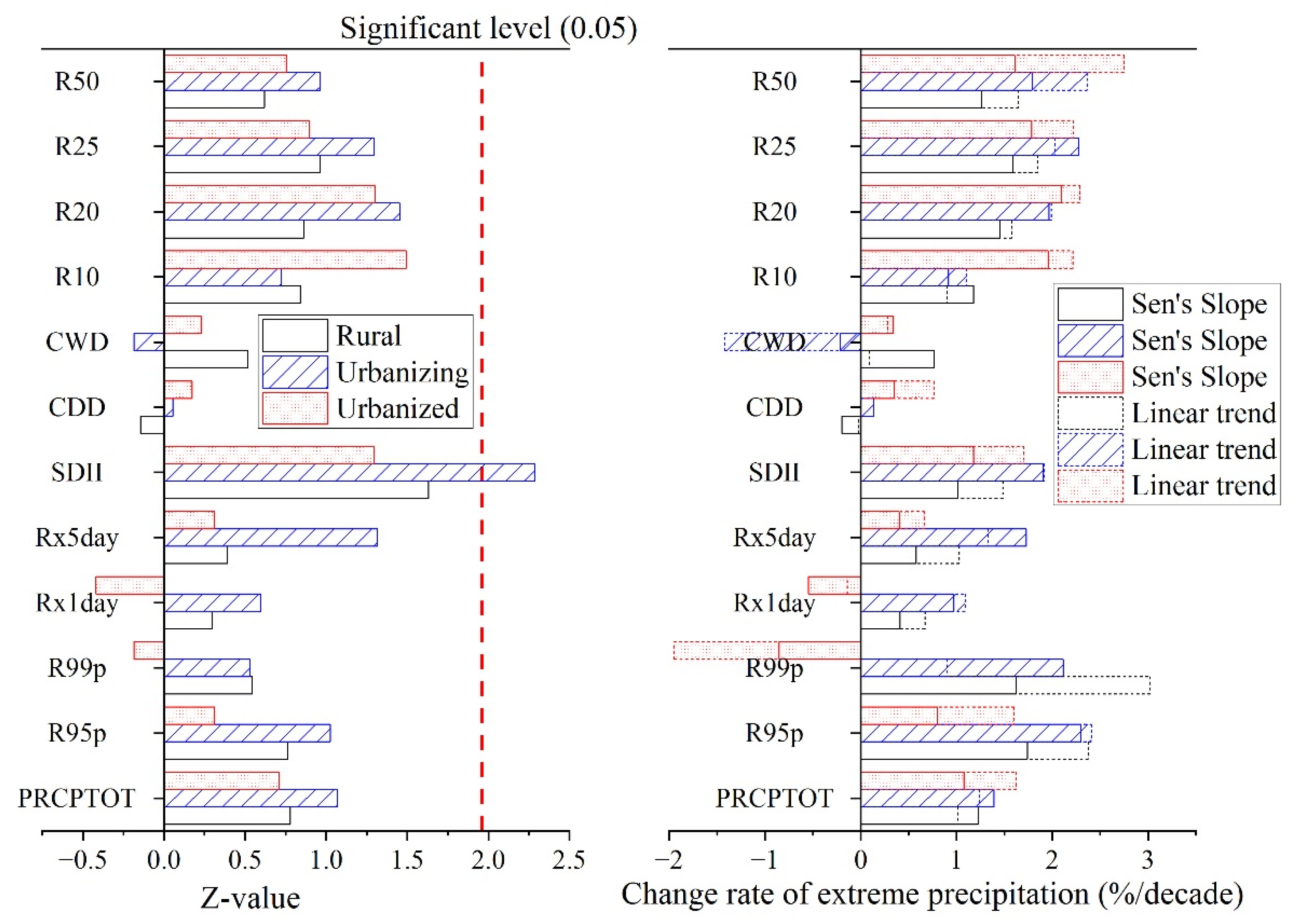




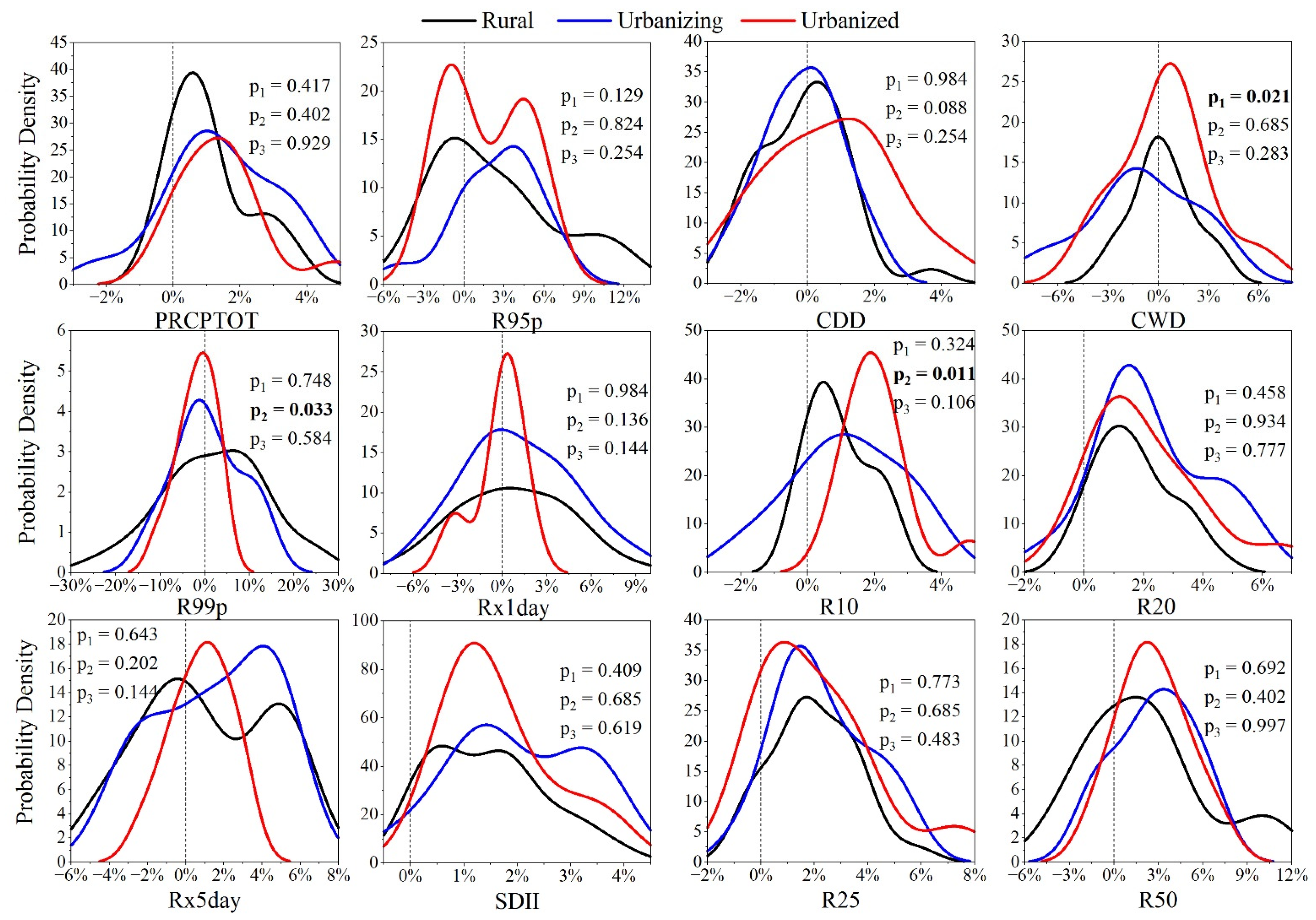
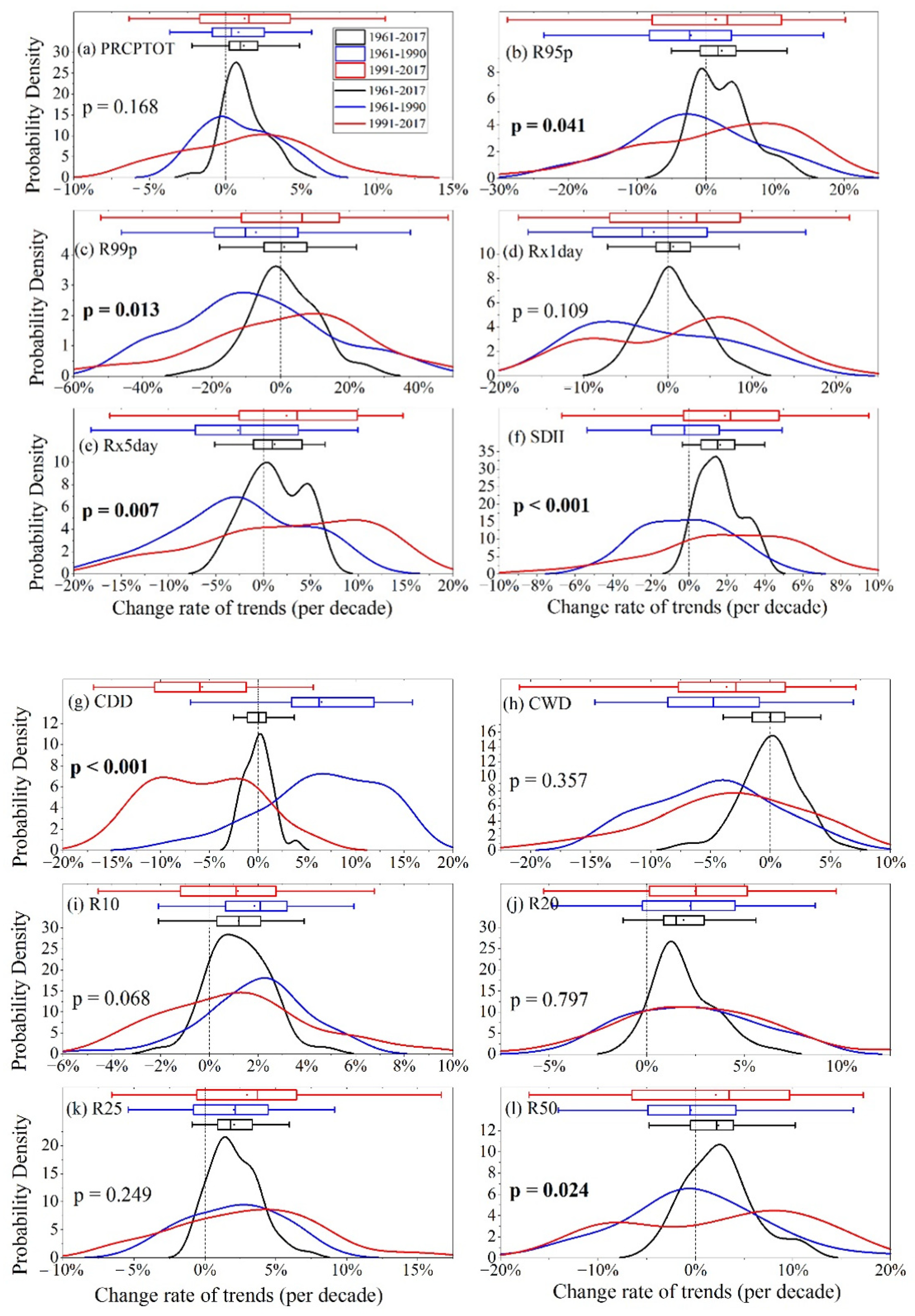

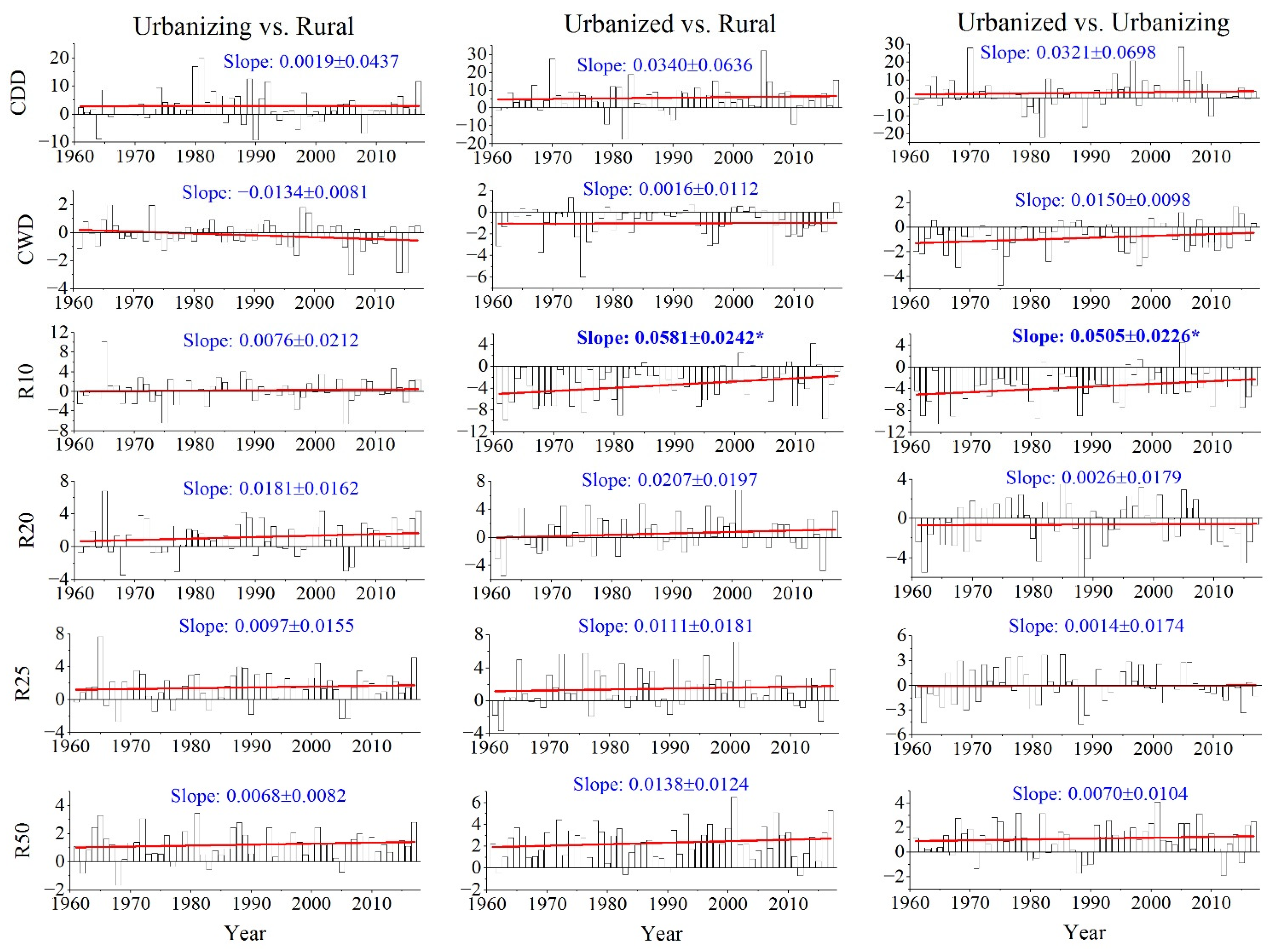
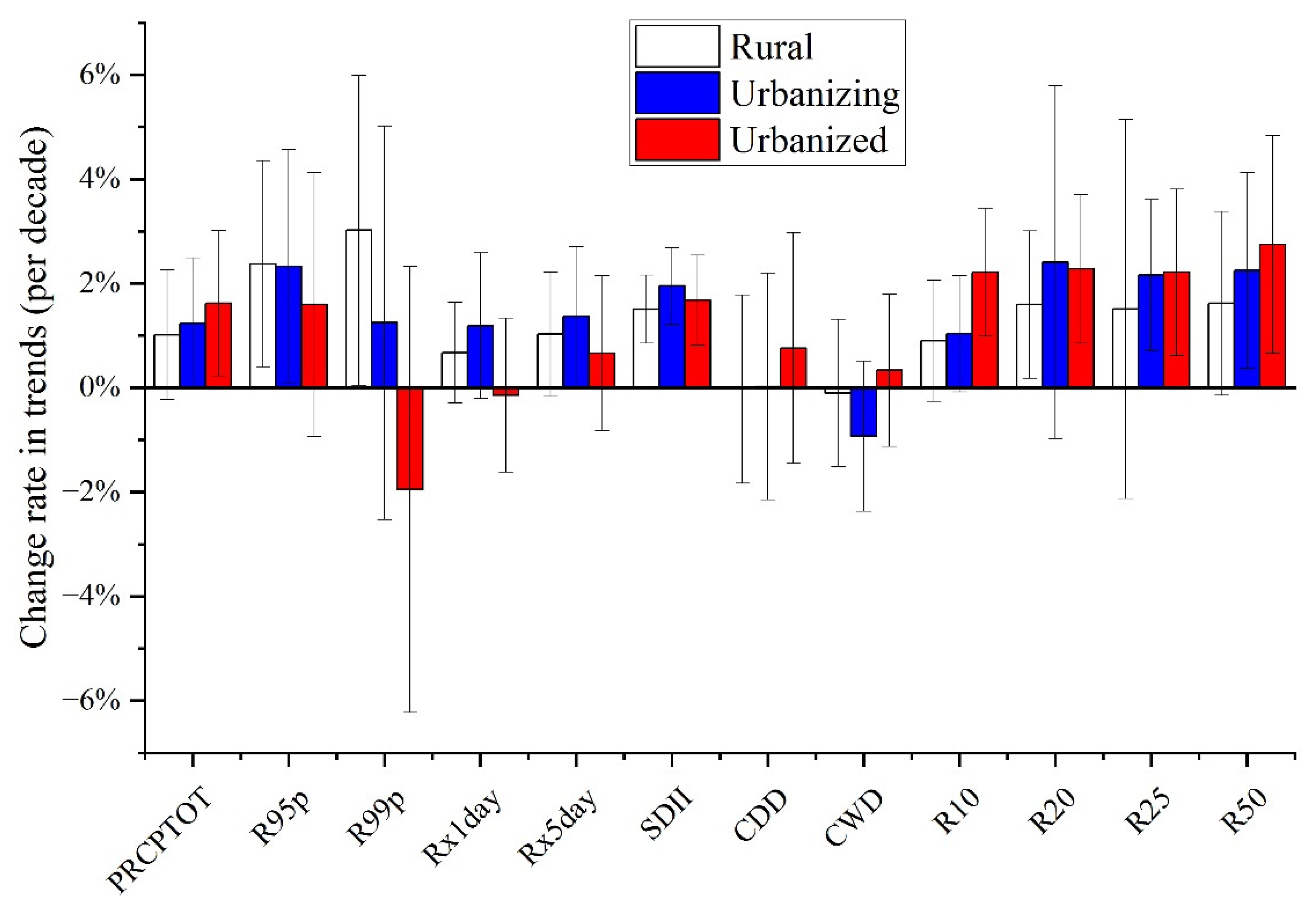
| Index | Definition | Unit |
|---|---|---|
| PRCPTOT | Annual total precipitation with precipitation ≥1 mm | mm |
| R95p | Annual total precipitation when precipitation >95% percentile | mm |
| R99p | Annual total precipitation when precipitation >99% percentile | mm |
| Rx1day | Maximum 1-day precipitation value | mm |
| Rx5day | Maximum 5-day precipitation value | mm |
| SDII | Mean precipitation intensity of days with precipitation ≥1 mm | mm/day |
| CDD | Maximum number of consecutive days with precipitation <1 mm | day |
| CWD | Maximum number of consecutive days with precipitation ≥1 mm | day |
| R10 | Number of days with precipitation ≥10 mm | day |
| R20 | Number of days with precipitation ≥20 mm | day |
| R25 | Number of days with precipitation ≥25 mm | day |
| R50 | Number of days with precipitation ≥50 mm | day |
| Index | Magnitude of Trends * | Increasing Trends # | Decreasing Trend | No Changes | ||||
|---|---|---|---|---|---|---|---|---|
| 1961–2017 | 1961–1990 | 1991–2017 | Significant | Not Significant | Significant | Not Significant | ||
| PRCPTOT | 21.56 ± 24.68 | 15.83 ± 43.22 | 20.86 ± 78.69 | 6 (0, 1) | 43 (35, 37) | 0 (0, 0) | 9 (23, 20) | 0 (0, 0) |
| R95p | 11.84 ± 20.27 | −9.91 ± 43.28 | 3.36 ± 69.90 | 6 (0, 1) | 29 (24, 35) | 0 (0, 2) | 23 (34, 20) | 0 (0, 0) |
| R99p | 3.41 ± 17.92 | −10.49 ± 37.97 | −1.95 ± 43.73 | 3 (1, 1) | 26 (20, 30) | 1 (0, 3) | 28 (37, 24) | 0 (0, 0) |
| Rx1day | 1.66 ± 5.14 | −1.06 ± 12.70 | 2.03 ± 13.98 | 4 (2, 3) | 29 (21, 33) | 1 (1, 1) | 24 (34, 21) | 0 (0, 0) |
| Rx5day | 3.27 ± 7.49 | −5.05 ± 17.90 | 4.46 ± 24.10 | 8 (0, 1) | 28 (18, 33) | 0 (2, 2) | 22 (38, 22) | 0 (0, 0) |
| SDII | 1.20 ± 0.18 | 0.92 ± 0.38 | 1.21 ± 0.68 | 13 (0, 3) | 43 (28, 40) | 0 (0, 1) | 2 (30, 14) | 0 (0, 0) |
| CDD | 0.96 ± 0.57 | 3.24 ± 2.50 | −1.18 ± 2.13 | 0 (1, 0) | 30 (47, 8) | 0 (0, 0) | 26 (10, 50) | 2 (0, 0) |
| CWD | 0.94 ± 0.24 | 0.49 ± 0.52 | 0.63 ± 0.62 | 1 (0, 0) | 28 (10, 17) | 2 (2, 3) | 27 (46, 38) | 0 (0, 0) |
| R10 | 1.50 ± 0.61 | 1.79 ± 1.07 | 1.49 ± 1.54 | 4 (0, 2) | 44 (49, 36) | 0 (0, 0) | 10 (9, 20) | 0 (0, 0) |
| R20 | 1.45 ± 0.44 | 1.54 ± 0.89 | 1.63 ± 1.20 | 10 (0, 3) | 43 (42, 41) | 0 (0, 0) | 5 (16, 14) | 0 (0, 0) |
| R25 | 1.37 ± 0.37 | 1.36 ± 0.71 | 1.57 ± 1.16 | 6 (0, 3) | 44 (39, 38) | 0 (0, 0) | 7 (19, 17) | 1 (0, 0) |
| R50 | 1.10 ± 0.23 | 0.92 ± 0.49 | 1.06 ± 0.71 | 7 (0, 0) | 34 (25, 36) | 0 (0, 0) | 16 (33, 22) | 1 (0, 0) |
| Index | Urbanizing vs. Rural | Urbanized vs. Rural | Urbanized vs. Urbanizing | Mean UC/% | |||
|---|---|---|---|---|---|---|---|
| UED | UCD /% | UED | UCD/% | UED | UCD/% | ||
| PRCPTOT | 13.86 mm | 15.55 | 62.71 mm | 52.36 | 48.85 mm | 100 * | 55.97 |
| R95p | 7.99 mm | 15.87 | 33.51 mm | 32.65 | 25.52 mm | 48.82 | 32.45 |
| R99p | −2.49 mm | 12.47 | −1.80 mm | 4.76 | 0.69mm | 3.85 | 3.85 |
| Rx1day | 3.41 mm | 19.62 | 3.02 mm | 7.06 | −0.39 mm | 1.53 | 13.34 |
| Rx5day | 2.85 mm | 11.71 | 7.89 mm | 12.25 | 5.04 mm | 12.58 | 12.18 |
| SDII | 0.33 mm/day | 29.87 | 0.65 mm/day | 20.30 | 0.32 mm/day | 15.33 | 21.83 |
| CDD | −1.03 day | 35.50 | 2.59 day | 45.11 | 3.62 day | 100 * | 72.56 |
| CWD | −0.26 day | 100 * | −0.04 day | 3.56 | 0.23 day | 26.27 | 63.14 |
| R10 | −0.09 day | 37.29 | 1.34 day | 39.75 | 1.43 day | 39.59 | 39.67 |
| R20 | 0.33 day | 27.99 | 0.62 day | 100 * | 0.29 day | 47.47 | 58.49 |
| R25 | 0.28 day | 18.97 | 0.48 day | 32.39 | 0.19 day | 100 * | 50.45 |
| R50 | 0.12 day | 9.67 | 0.74 day | 31.75 | 0.62 day | 56.10 | 32.51 |
| Mean | -- | 27.69 | -- | 37.36 | -- | 50.00 | |
| Index | Urbanizing vs. Rural | Urbanized vs. Rural | Urbanized vs. Urbanizing | Mean UC/% | |||
|---|---|---|---|---|---|---|---|
| UEΔR | UCΔR/% | UEΔR | UCΔR/% | UEΔR | UCΔR/% | ||
| PRCPTOT | 0.006 | 18.07 | 0.033 | 53.44 | 0.026 | 43.17 | 38.23 |
| R95p | 0.008 | 8.35 | 0.047 | 35.50 | 0.039 | 29.63 | 24.49 |
| R99p | −0.030 | 32.47 | −0.035 | 39.96 | −0.005 | 5.65 | 26.03 |
| Rx1day | 0.023 | 56.17 | 0.014 | 43.99 | −0.009 | 27.81 | 42.66 |
| Rx5day | 0.008 | 16.37 | 0.020 | 32.37 | 0.012 | 19.13 | 22.62 |
| SDII | 0.018 | 26.87 | 0.028 | 37.25 | 0.011 | 14.20 | 26.11 |
| CDD | −0.024 | 100 * | 0.063 | 60.66 | 0.086 | 100 * | 86.89 |
| CWD | −0.027 | 100 * | 0.001 | 1.57 | 0.028 | 64.76 | 55.44 |
| R10 | −0.002 | 8.34 | 0.032 | 55.32 | 0.034 | 58.76 | 40.81 |
| R20 | 0.010 | 19.26 | 0.022 | 34.24 | 0.012 | 18.56 | 24.02 |
| R25 | 0.010 | 16.71 | 0.019 | 27.93 | 0.009 | 13.47 | 19.37 |
| R50 | 0.007 | 10.27 | 0.073 | 55.96 | 0.067 | 50.92 | 39.05 |
| Mean | -- | 34.41 | -- | 39.85 | -- | 37.17 | |
Publisher’s Note: MDPI stays neutral with regard to jurisdictional claims in published maps and institutional affiliations. |
© 2022 by the authors. Licensee MDPI, Basel, Switzerland. This article is an open access article distributed under the terms and conditions of the Creative Commons Attribution (CC BY) license (https://creativecommons.org/licenses/by/4.0/).
Share and Cite
Song, X.; Qi, J.; Zou, X.; Zhang, J.; Liu, C. Potential Effects of Urbanization on Precipitation Extremes in the Pearl River Delta Region, China. Water 2022, 14, 2466. https://doi.org/10.3390/w14162466
Song X, Qi J, Zou X, Zhang J, Liu C. Potential Effects of Urbanization on Precipitation Extremes in the Pearl River Delta Region, China. Water. 2022; 14(16):2466. https://doi.org/10.3390/w14162466
Chicago/Turabian StyleSong, Xiaomeng, Jiachen Qi, Xianju Zou, Jianyun Zhang, and Cuishan Liu. 2022. "Potential Effects of Urbanization on Precipitation Extremes in the Pearl River Delta Region, China" Water 14, no. 16: 2466. https://doi.org/10.3390/w14162466
APA StyleSong, X., Qi, J., Zou, X., Zhang, J., & Liu, C. (2022). Potential Effects of Urbanization on Precipitation Extremes in the Pearl River Delta Region, China. Water, 14(16), 2466. https://doi.org/10.3390/w14162466







